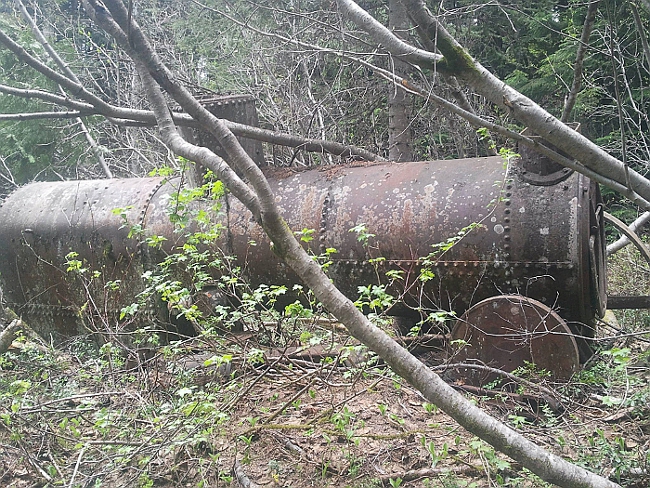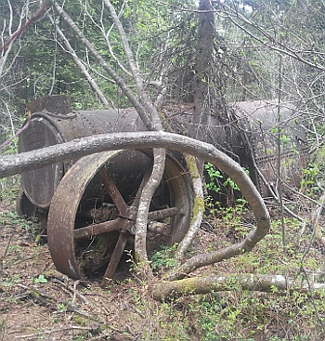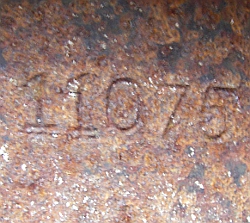Found, lost, found again
|
|
December 27, 2013 |
 |
Story by Mike Weland
Photos and history by Gary Regehr
 Gary
Regehr has spent a lifetime in the woods. As
owner of Regehr logging, he's seen and worked
places most of us can only dream about. And over
the years, he came across signs of history,
signs of the toil our forbears endured to carve
a living of the abundant natural resources of
this once forbidding place. Gary
Regehr has spent a lifetime in the woods. As
owner of Regehr logging, he's seen and worked
places most of us can only dream about. And over
the years, he came across signs of history,
signs of the toil our forbears endured to carve
a living of the abundant natural resources of
this once forbidding place.
Now, the young loggers do much of the hard
day-to-day work for him, leaving Gary with time
to go back and chronicle those rare, hidden
places he happened upon over the course of
decades. Old mines, chipped out of hard stone
with nothing but picks, shovels and sweat, old
cabins long dilapidated that sheltered the
hearty souls who lived miles from nowhere,
reliant upon none but themselves.
This is a story Gary recently posted on the
Facebook site
Bonners Ferry Back When, one of several he's
posted, but this one is a story unto itself,
showing that stamina and perseverance aren't
traits of men lost to history, but traits that
still abide.
 "I’ll
tell you a short story on how we first found
it," Regehr wrote. "And when I finally found it
again. About 25 years ago Dave Wattenbarger and
myself were hiking on Dodge Peak and stumbled
across this steam donkey saw mill. Didn’t have
GPS or cell phones back then and soon forgot
about it. So when I started looking for mines
and interesting places I’d been over the years,
I forgot where it was." "I’ll
tell you a short story on how we first found
it," Regehr wrote. "And when I finally found it
again. About 25 years ago Dave Wattenbarger and
myself were hiking on Dodge Peak and stumbled
across this steam donkey saw mill. Didn’t have
GPS or cell phones back then and soon forgot
about it. So when I started looking for mines
and interesting places I’d been over the years,
I forgot where it was."
He spent the past four or five years looking for
it, off and on, then followed an old flume road
until he finally spotted it. It wasn't he said,
where'd he'd remembered it.
"There’s an old homestead at the bottom of Dodge
Creek near where the flume flattens out on the
valley floor near what we now call McArthur
Lake," he wrote. "As I started up the flume road
I spotted one old broken cable hanging in a
tree. I’m guessing as the donkey pulled itself
up the trail, it got hung up and broke the
cable. Cable looked a lot different in the old
days.
"As I continued up the trail I saw where the
water flume failed in a couple of places and
made some pretty serious washouts. I came to an
old wooden bridge where the flume left the trail
and in a little draw I found the only wooden
remnants of the flume in the 2.5 mile of flume.
"When I spotted the steam donkey I looked around
for their camp. I believe it was just above the
donkey. I found a bucket, crosscut saw, scoop
shovel and pan."
After finally rediscovering the old historical
treasure, he realized, belatedly,
that about six years ago, while logging for JD
Lumber up on the north side of Dodge Creek,
their landing was a mere 100 yards from the old
sawmill, and no one knew it.
Gary wasn't content to just get pictures of the
old donkey mill, he wanted to know its history,
so he took shots of all the identifying marks he
could find and turned them over to Jerry Garten,
Idaho Department of Lands, who did all the
research and write up from what he found online.
 Russell
& Co. Steam Engine No. 11075 Russell
& Co. Steam Engine No. 11075
Russell & Co. built steam engine No. 11075 in
1902 in Massillon , Ohio. Steam Engine No. 11075
was 15.5 feet long and had a 22 foot smoke
stack. The cylinder had a 12 inch diameter and
it was equipped with one 60 inch belt wheel and
a 26 inch fly wheel that was attached to a
winch.
Between 1902 and the 1920s this engine was moved
to Boundary County, Idaho, along with a Russell
& Co. saw mill.
The sawmill was built on a 26 foot frame and had
two four-foot circular saws mounted one above
the other, which allowed it to cut up to four
foot diameter logs.
In the early 1900s, Steam engine No. 11075
started the journey from the old county road
where it crosses Dodge Creek (Lanes Canyon) to
the present location. The road, built for the
steam engine up into the head waters of Dodge
Creek, is approximately 2.5 miles long.
 The
steam engine pulled itself, the saw mill and any
extra parts and equipment. The
steam engine pulled itself, the saw mill and any
extra parts and equipment.
At the present location the engine and mill were
set up and the lumber produced was used to build
a flume back down Dodge Creek and over to the
Great Northern railroad track next to the outlet
of present day MacArthur Lake.
The area logged extended from 500 feet below the
saw mill to 1.5 miles above the saw mill and on
both sides of the creek.
In 1929 a forest fire burned the entire Dodge
Creek drainage, the steam engine and the saw
mill.
The fire consumed all the remaining timber and
destroyed the saw mill, which leaves us to
speculate on several things:
* The species of trees that they were cutting (the only burned
stumps left were cedar).
* The location of the camp.
* The method of moving logs to the mill (horses, tractor).
* Did the flume extend beyond the saw mill? |
|
Questions or comments about this
article?
Click here to e-mail! |
|
|
|
|

